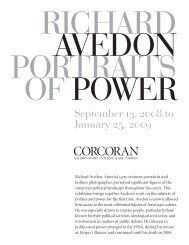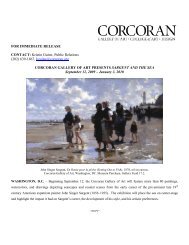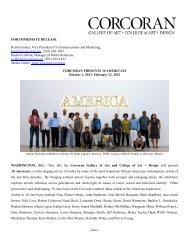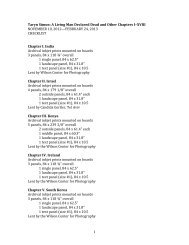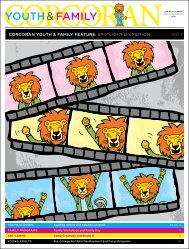Aaron Douglas, Into Bondage, 1936 - Corcoran Gallery of Art
Aaron Douglas, Into Bondage, 1936 - Corcoran Gallery of Art
Aaron Douglas, Into Bondage, 1936 - Corcoran Gallery of Art
Create successful ePaper yourself
Turn your PDF publications into a flip-book with our unique Google optimized e-Paper software.
Charles Bird King (born Newport, RI, 1785–died Washington, D.C., 1862)<br />
Poor <strong>Art</strong>ist’s Cupboard, c. 1815<br />
Oil on panel, 29 13/16 x 27 13/16 in. (75.7 x 70.7 cm)<br />
Museum Purchase, <strong>Gallery</strong> Fund and Exchange, 1955<br />
About the <strong>Art</strong>ist<br />
Born in Newport, Rhode Island, Charles Bird King began his formal<br />
art training in New York with portraitist Edward Savage. He later<br />
moved to London, where he lived for seven years, to continue<br />
studying with painter Benjamin West. He returned to the U.S.<br />
to live and work in Philadelphia, but had a lackluster career,<br />
selling only two portraits during his four years there. King settled<br />
in Washington D.C. in 1818, where he achieved great success as<br />
a painter <strong>of</strong> society and diplomatic portraits. In addition, he ran<br />
a for-pr<strong>of</strong>it gallery in his home on Twelfth Street where he exhibited<br />
his own paintings. King’s portraits <strong>of</strong> Henry Clay and John C. Calhoun,<br />
both commissioned while King resided in D.C., are in the <strong>Corcoran</strong>’s<br />
collection. Although he was from a family <strong>of</strong> means and apparently<br />
never had to support himself through the sales <strong>of</strong> his works, at times<br />
King chose to live in self-imposed privation; as a student in London,<br />
he and portraitist Thomas Sully shared a small, one-room apartment<br />
and subsisted on bread, milk, and potatoes in order to stretch their<br />
budgets. King is best known for his paintings <strong>of</strong> Native American<br />
delegates to the nation’s capital, making him one <strong>of</strong> the first<br />
portraitists <strong>of</strong> Western tribal leaders. Unfortunately, many <strong>of</strong> these<br />
works were destroyed in an 1865 fire at the Smithsonian Institution.<br />
About the <strong>Art</strong><br />
Although King based Poor <strong>Art</strong>ist’s Cupboard on personal experience,<br />
he was not by any means a “starving artist.” The still life painting<br />
has been understood by art historians to be a meditation on the<br />
impoverishment <strong>of</strong> cultural life—especially that <strong>of</strong> Philadelphia—<br />
as symbolized by the tattered books and papers. Through the various<br />
objects in the niche, King introduces his audience to the sad story<br />
<strong>of</strong> fictional artist, C. Palette. Drafting tools are at the center, flanked<br />
by a crust <strong>of</strong> bread—perched, ironically, on a richly bound art<br />
history tome—and a humble glass <strong>of</strong> water. Just below are two<br />
calling cards, each addressed to Mr. Palette. One, from a miserly<br />
patron, Mrs. Skinflint, requests that he visit her after tea, and<br />
a second asks Palette to repay a debt <strong>of</strong> five dollars that he owes<br />
to a “lover <strong>of</strong> the arts.” Above, two thin volumes bear handwritten<br />
titles which were traditional proverbs about poverty: “We Fly by<br />
Night” and “No Song, no Supper.” On top <strong>of</strong> them lies a stack<br />
<strong>of</strong> unpaid bills. Surrounding these objects is a host <strong>of</strong> books with<br />
rather gloomy titles: The Miseries <strong>of</strong> Life, The Advantages <strong>of</strong> Poverty<br />
– Part III, and Cheyne’s Vegetable Diet. At the upper left <strong>of</strong> this<br />
tableau is an advertisement for a Sheriff’s Sale listing the “property<br />
<strong>of</strong> an artist,” a few articles <strong>of</strong> clothing, a peck <strong>of</strong> potatoes, and<br />
several still lifes <strong>of</strong> rich repasts painted “from recollection.”<br />
King’s trompe l’oeil panel is also reminiscent <strong>of</strong> Dutch still life<br />
paintings in the tradition <strong>of</strong> vanitas, which are contemplations<br />
on the fleeting pleasures <strong>of</strong> life. Indeed the tattered books, as well<br />
as the cylinder <strong>of</strong> papers—which one art historian has observed<br />
when viewed obliquely resembles a skull—suggest decay and death.<br />
Suggested Dialogue<br />
• How do we know that fictional artist C. Palette is poor?<br />
Are King’s visual clues easily translated by 21st-century audiences?<br />
• If you were to construct a still life about a contemporary<br />
struggling artist, what objects would you include?<br />
What would you name the fictional artist?<br />
• Do you think King is sympathetic with Palette’s circumstances?<br />
Note the beaver top hat on the right; do you think that would<br />
be an item that an artist <strong>of</strong> little means would typically possess?<br />
Extended Dialogue<br />
• If you created an “identity niche” to describe yourself, what<br />
would you include? Would your family and friends be able<br />
to recognize you from the items in your niche?<br />
Vocabulary<br />
Benjamin West (1738-1820): An Anglo-<br />
American Neoclassical painter <strong>of</strong> historical<br />
scenes and portraits during and after the<br />
time <strong>of</strong> the Revolutionary War.<br />
Henry Clay (1777-1852): A 19th-century<br />
American statesman and orator who<br />
represented Kentucky in both the Senate<br />
and the House <strong>of</strong> Representatives, where<br />
he served as Speaker. He also served as<br />
Secretary <strong>of</strong> State from 1825 to 1829.<br />
John C. Calhoun (1782-1850): The seventh<br />
Vice President <strong>of</strong> the United States and<br />
a leading Southern politician from South<br />
Carolina during the first half <strong>of</strong> the 19th<br />
century.<br />
Portrait: A portrait is a painting,<br />
photograph, sculpture, or other artistic<br />
representation <strong>of</strong> a person, in which the<br />
face and its expression is predominant.<br />
The intent is to display the likeness,<br />
personality, and even the mood <strong>of</strong><br />
the person.<br />
Still life: An arrangement or work<br />
<strong>of</strong> art showing a collection or grouping<br />
<strong>of</strong> inanimate objects.<br />
Vanitas: The word is Latin, meaning<br />
“emptiness.” A type <strong>of</strong> symbolic work <strong>of</strong><br />
art especially associated with Northern<br />
European still life painting in the 16th<br />
and 17th centuries.<br />
Trompe l’oeil: Trompe l’oeil is French for<br />
“deceive the eye.” This term is used to<br />
describe pictures in which a deliberate<br />
visual illusion is intended by the artist.<br />
Niche: A niche is an architectural recess<br />
in a wall or the like, usually semicircular<br />
in plan and arched, as for a statue or other<br />
decorative object.<br />
Support for <strong>Art</strong>s 101 materials is made possible in part by the Women’s Committee <strong>of</strong> the <strong>Corcoran</strong> and the DC Commission on the <strong>Art</strong>s and Humanities.


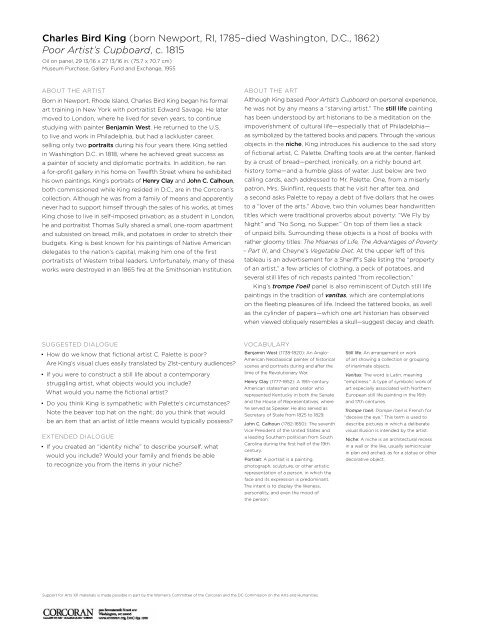
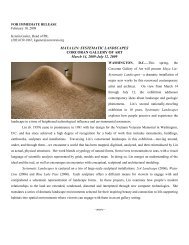
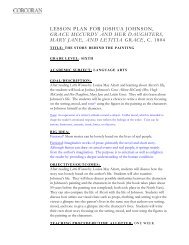
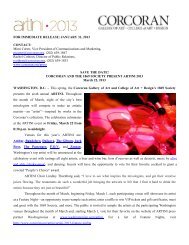


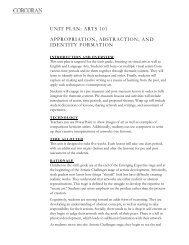
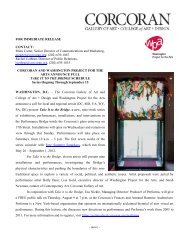

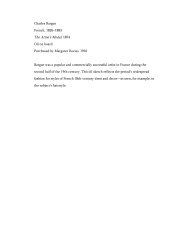
![[PDF] Ellen Harvey: The Alien's Guide to the Ruins of Washington, DC](https://img.yumpu.com/32942537/1/190x190/pdf-ellen-harvey-the-aliens-guide-to-the-ruins-of-washington-dc.jpg?quality=85)
